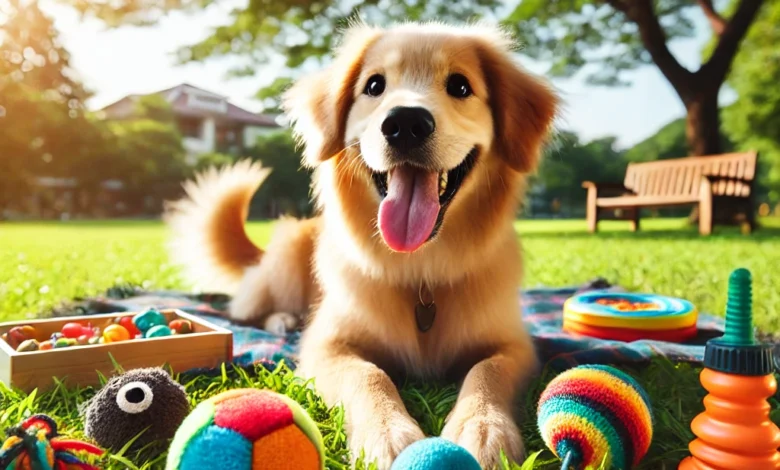How to Train Your Dog Using Play and Reward Toys

Training your dog should be a fun and rewarding experience, both for you and your furry friend. Instead of relying on strict discipline or boring repetition, incorporating play and reward toys can turn training into an exciting and positive bonding experience. This method not only makes learning enjoyable but also strengthens the trust and connection between you and your dog.
In this comprehensive guide, we’ll explore how to use play and reward toys effectively in training. From choosing the right toys to reinforcing good behavior, we’ll cover everything you need to know to raise a well-behaved and happy pup.
Introduction
Training your dog doesn’t have to feel like a chore. By using play and reward toys, you can turn learning into an exciting adventure for both of you. Dogs naturally love to play, so incorporating toys into training sessions taps into their instincts, making learning more effective. Whether you have a puppy or an older dog, using toys as positive reinforcement can create a well-behaved and happy companion.
The Benefits of Using Play and Reward Toys in Training
1. Encourages Engagement and Motivation
Dogs respond better when they enjoy the training process. Toys make learning feel like playtime, keeping your dog eager to participate.
2. Reduces Stress and Anxiety
Training should never feel like punishment. Reward-based play makes learning stress-free and enjoyable, helping anxious or shy dogs gain confidence.
3. Strengthens the Human-Dog Bond
Playing together builds trust and deepens your connection. When training is fun, your dog will be more responsive to your commands.
Choosing the Right Training Toys
Not all toys are created equal when it comes to training. Here are some great options:
- Interactive Toys – Toys that dispense treats or require problem-solving help keep dogs engaged and mentally stimulated.
- Tug Toys – Great for teaching impulse control and strengthening bite inhibition.
- Puzzle Toys – Encourage problem-solving and prevent boredom.
- Fetch Toys – Useful for recall training and promoting exercise.
Using play and reward-based training can be highly effective—browse top-rated training toys at https://furlove365.com/.
Understanding Your Dog’s Motivation
Every dog has different preferences. Some are food-driven, while others love chasing or tugging. Identifying what excites your dog will make training more effective.
- Food-motivated dogs respond well to treat-dispensing toys.
- Toy-driven dogs prefer fetch, tug, or squeaky toys as rewards.
Experiment to see what excites your pup the most!
Basic Training Commands Using Toys
You can use play and reward toys to teach essential commands:
- Sit: Hold a toy above your dog’s head and move it back slightly. When your dog sits, reward with the toy.
- Stay: Use a toy to keep your dog’s focus while reinforcing the stay command.
- Come: Call your dog while holding their favorite toy as motivation.
- Leave it: Teach impulse control by asking your dog to ignore a toy before rewarding them with it.
How to Use Tug Toys for Training
Tug games are excellent for training impulse control. Teach your dog to:
- Start and stop playing on command.
- Drop the toy when asked.
- Stay calm and wait before grabbing the toy.
Using Fetch Toys for Obedience Training
Fetch isn’t just a game—it’s a training tool!
- Use fetch to reinforce the “come” command.
- Teach patience by having your dog “stay” before chasing the toy.
- Encourage focus by making your dog wait before throwing the toy.
Reward-Based Puzzle Toys for Mental Stimulation
Puzzle toys encourage problem-solving and prevent boredom. These are great for:
- Teaching patience and persistence.
- Keeping your dog occupied when alone.
- Slowing down fast eaters.
Clicker Training with Play and Toys
Clicker training pairs well with play-based rewards. Click when your dog performs a desired action, then immediately reward with a toy. This method enhances consistency and understanding.
Using Toys to Reduce Unwanted Behavior
Dogs often misbehave out of boredom. Toys can help redirect bad habits:
- Chewing – Give them a chew toy instead of furniture.
- Barking – Use toys to distract and refocus their energy.
The Role of Tug-of-War in Training
Many people think tug-of-war encourages aggression, but when played correctly, it teaches control and discipline. Set clear rules:
- The game starts and stops when you decide.
- Your dog must release the toy on command.
- Play remains calm and controlled.
Socialization Through Play
Play helps dogs feel comfortable in new environments. Use toys to:
- Encourage positive interactions with other dogs.
- Make new experiences (like vet visits) less scary.
- Prevent fear-based reactions.
Play and Exercise: Keeping Your Dog Healthy
Training with toys keeps your dog physically and mentally fit. Regular play prevents obesity, boosts energy levels, and improves overall well-being.
Common Mistakes to Avoid When Training with Toys
- Overusing toys – Dogs should obey commands even when no toys are present.
- Using toys as bribery – Rewards should reinforce, not replace, proper behavior.
- Allowing play aggression – Keep play structured to prevent bad habits.
Conclusion and Final Tips
Training with play and reward toys makes learning fun and effective. Whether using tug, fetch, or puzzle toys, the key is consistency, patience, and enthusiasm. When your dog sees training as a game, they’ll be eager to learn!